To master cinematic figure-eight drone moves, you'll need a high-quality drone with a 3-axis gimbal and 4K camera. Start by conducting thorough pre-flight checks and scanning your surroundings for hazards. Position your drone at one end of the flight path and slowly fly forward, gently turning to create a wide arc. Practice maintaining consistent altitude and speed while completing the maneuver. For smoother motion, fine-tune your drone settings and incorporate dynamic speed control. In post-production, stabilize your footage and apply color grading for a polished look. With these steps, you'll be on your way to capturing stunning aerial shots that will impress your audience.
Key Takeaways
- Master the basic figure-eight pattern by flying forward in wide arcs, reversing direction to complete the shape.
- Maintain consistent altitude and speed for fluid motion, gradually varying these for dynamic shots.
- Practice dynamic speed control: start slow, increase pace mid-flight, then decelerate smoothly.
- Incorporate gentle yaw movements and camera tilts to keep the subject centered and capture diverse angles.
- Fine-tune drone settings for improved gimbal sensitivity and control stick responsiveness to enhance overall smoothness.
Equipment Needed
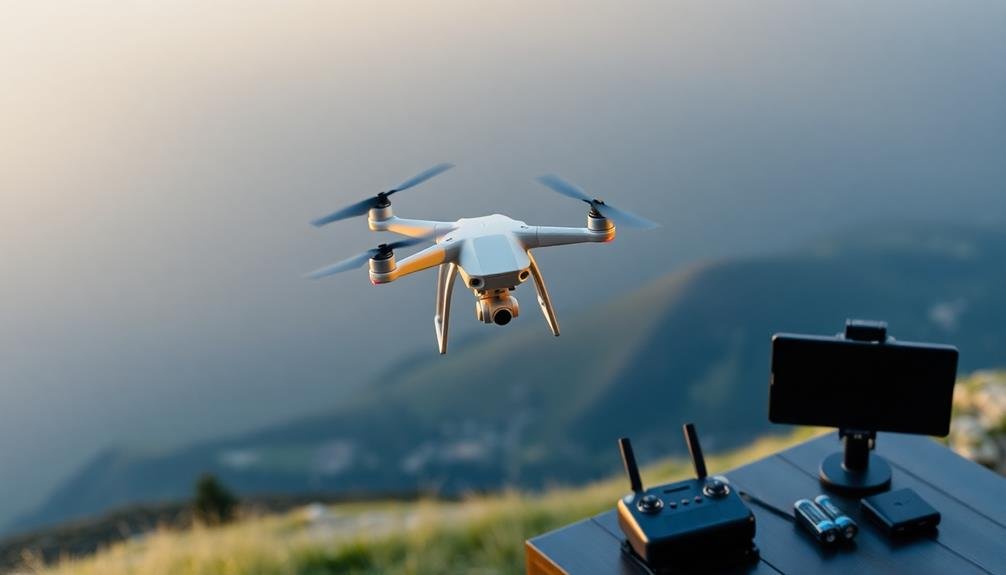
The essential equipment for cinematic drone moves includes a high-quality drone, preferably with a 3-axis gimbal for smooth footage.
You'll want a drone with obstacle avoidance sensors and GPS positioning to guarantee safe and accurate flight paths. Opt for a model with a 4K camera capable of at least 30 frames per second for crisp, professional-looking shots.
Don't forget spare batteries to extend your flight time and allow for multiple takes. A set of ND filters is vital for controlling exposure in bright conditions.
You'll also need a reliable remote controller with a built-in or attachable screen for real-time video feed.
For post-production, invest in a powerful computer with video editing software. A large, color-accurate monitor will help you fine-tune your footage.
Consider a portable hard drive for storing and backing up your video files.
Lastly, familiarize yourself with local drone regulations and obtain necessary permits. Safety equipment like propeller guards and a landing pad can protect your drone and surroundings.
With this gear, you'll be well-equipped to capture stunning cinematic drone moves.
Safety Precautions
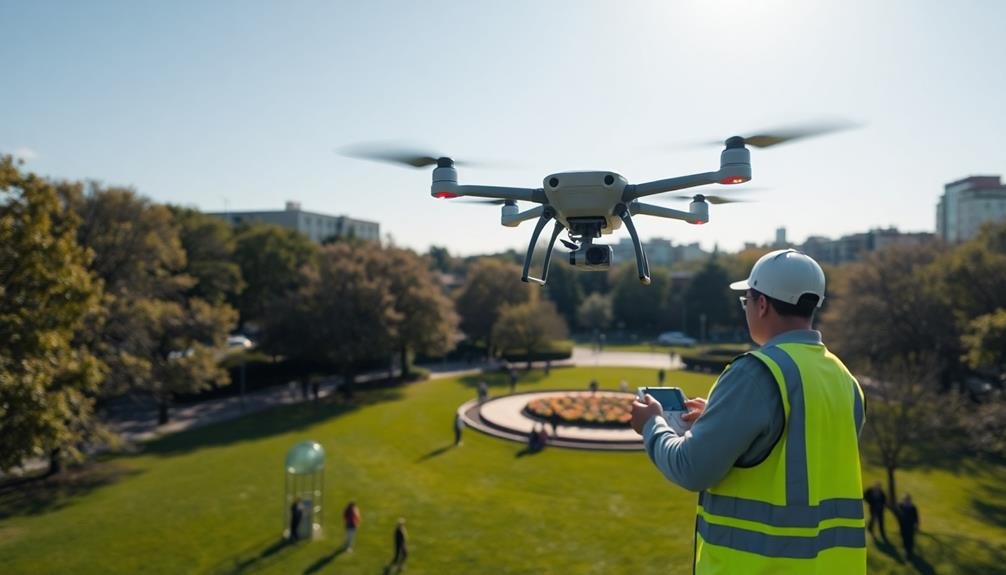
Before you take flight, always perform thorough pre-flight equipment checks to guarantee your drone is in ideal condition.
You'll need to maintain constant awareness of your surroundings, including obstacles, weather conditions, and local regulations.
It's vital to familiarize yourself with emergency landing procedures in case of unexpected issues during your flight.
Pre-Flight Equipment Checks
Making certain your drone is in peak condition before each flight is essential for both safety and capturing stunning aerial footage.
Before you take off, conduct a thorough pre-flight equipment check to minimize risks and enhance performance.
Start by inspecting your drone's physical components. Look for any cracks, dents, or loose parts that could compromise its stability. Check the propellers for damage and confirm they're securely attached.
Next, examine the battery. Make sure it's fully charged and properly connected. Test the camera and gimbal, verifying that they move smoothly and respond to commands.
Don't forget to review your controller's settings and calibrate the compass if needed. Finally, update your drone's firmware to the latest version for peak performance and security.
Here's a quick checklist to guide your pre-flight equipment checks:
- Inspect drone body and propellers for damage
- Check battery charge and connection
- Test camera and gimbal functionality
- Verify controller settings and compass calibration
- Update drone firmware
Awareness of Surroundings
With your drone ready for flight, it's time to turn your attention to the environment. Carefully scan the area for potential hazards that could interfere with your figure-eight maneuver. Look for obstacles like trees, power lines, buildings, or other structures that might obstruct your flight path.
Be aware of any people or animals in the vicinity, as their sudden movements could pose a risk.
Check the weather conditions, including wind speed and direction. Strong gusts can affect your drone's stability and trajectory, especially during complex moves like figure-eights. If possible, choose a location with minimal air traffic to avoid conflicts with other aircraft.
Consider the lighting conditions and how they might impact your footage. The sun's position can create glare or shadows that affect the quality of your shots. Be mindful of any reflective surfaces in the area that could interfere with your drone's sensors or camera.
Lastly, make sure you're complying with local drone regulations. Check for any no-fly zones, altitude restrictions, or required permits in your chosen location.
Emergency Landing Procedures
Several key emergency landing procedures should be firmly ingrained in your mind before attempting any cinematic drone moves.
Familiarize yourself with your drone's return-to-home function and know how to activate it instantly. Always maintain visual line of sight with your drone, even when using FPV goggles. If you lose control or encounter technical difficulties, immediately switch to manual mode and attempt to regain control.
In case of an imminent crash, prioritize safety over equipment. Aim for soft landing spots like grass or bushes, avoiding water, people, and structures. If possible, cut the motors before impact to minimize damage.
After an emergency landing, assess the situation carefully before approaching the drone.
Here are five essential emergency landing procedures to remember:
- Activate return-to-home function
- Switch to manual mode if automated systems fail
- Aim for soft landing spots
- Cut motors before impact if possible
- Assess the situation before approaching the downed drone
Setting Up Your Drone
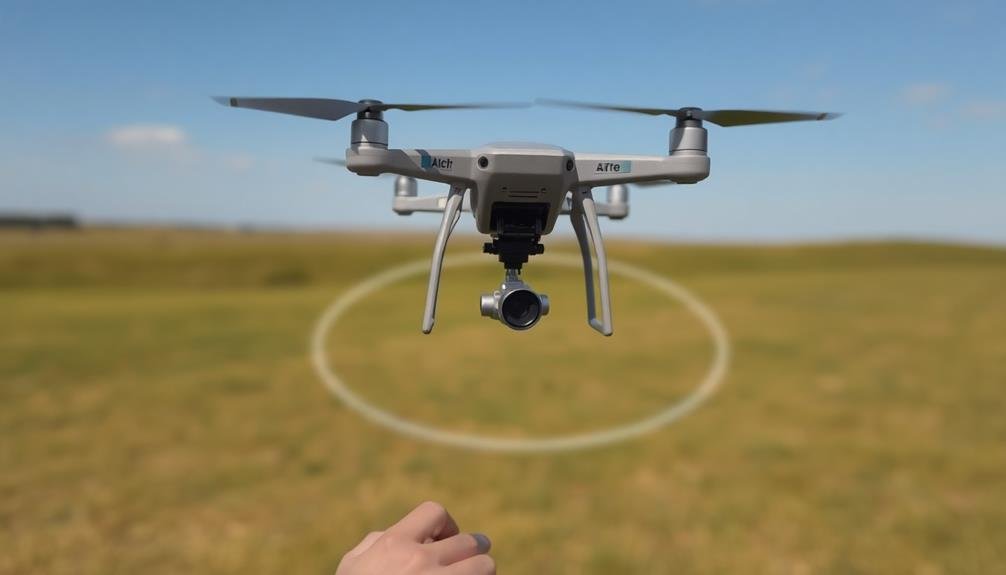
Before you take flight, run through your pre-flight checklist to verify your drone is ready for action.
You'll want to inspect the propellers, check battery levels, and calibrate your compass and GPS.
Choose a takeoff location that's clear of obstacles and provides ample space for your planned cinematic moves.
Pre-Flight Checklist Essentials
Getting your drone ready for flight is essential for capturing cinematic shots. Before taking off, you'll need to complete a thorough pre-flight checklist to guarantee safety and peak performance.
Start by inspecting your drone's physical condition, checking for any visible damage or loose parts. Confirm your batteries are fully charged and properly inserted.
Next, calibrate your drone's compass and gimbal to assure accurate flight controls and smooth camera movements.
Don't forget to check your camera settings, including resolution, frame rate, and exposure. Set your desired flight mode and adjust any relevant parameters.
Finally, review local regulations and weather conditions to confirm a safe and legal flight.
Here's a quick pre-flight checklist:
- Inspect drone for physical damage
- Check battery levels and secure installation
- Calibrate compass and gimbal
- Adjust camera settings
- Review flight mode and parameters
Optimal Takeoff Location
Success in drone cinematography hinges on choosing the right takeoff location. You'll want to find a spot that's clear of obstacles and provides a stable, level surface for your drone to launch from. Look for an area with minimal interference from trees, power lines, or buildings that could disrupt your signal or pose collision risks.
Consider the direction of the sun and wind when selecting your takeoff point. Positioning yourself with the sun at your back will improve visibility and reduce glare on your control screen. Launching into the wind can provide more stability for your drone during takeoff.
Ensure you have enough space around you to maintain visual line of sight with your drone throughout the flight. This is essential for safety and legal compliance. If you're planning complex moves like figure-eights, choose a location that allows for a wide field of view and ample flying space.
Lastly, be mindful of your surroundings and respect privacy. Avoid launching near residential areas or sensitive locations.
Basic Figure-Eight Flight Pattern
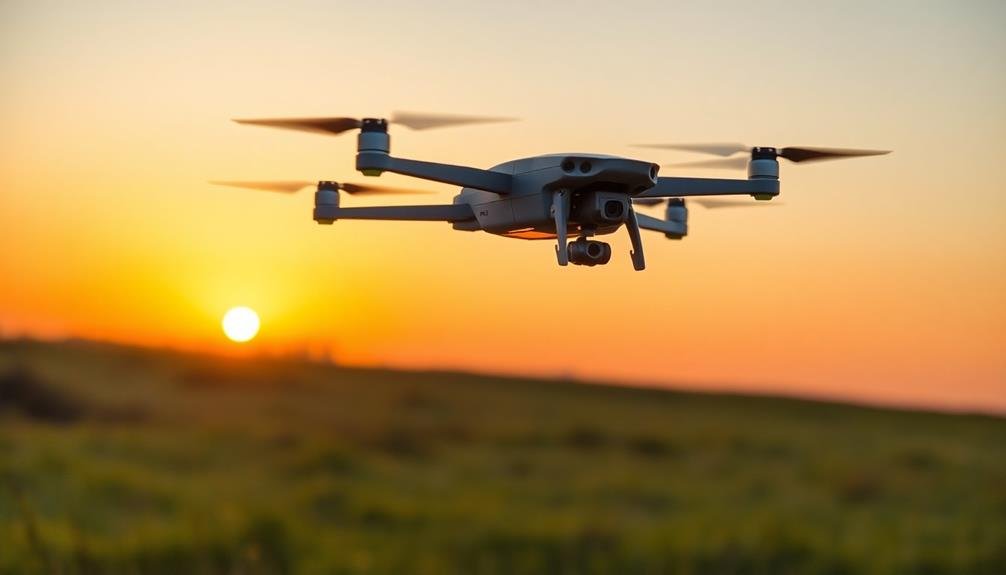
The basic figure-eight flight pattern is an essential move for drone cinematographers to master. This maneuver allows you to capture smooth, flowing footage while showcasing your subject from multiple angles.
To execute a figure-eight, start by positioning your drone at one end of your intended flight path. Slowly fly forward while gently turning to one side, creating a wide arc. As you complete the first loop, reverse your turn to create the opposite arc, forming the figure-eight shape.
Practice maintaining a consistent altitude and speed throughout the move to guarantee fluid motion in your footage. As you become more comfortable with the basic pattern, experiment with different variations:
- Vertical figure-eight: Perform the move on a vertical plane
- Ascending/descending figure-eight: Gradually increase or decrease altitude
- Varying speed: Slow down at the curves and accelerate on straightaways
- Tilting camera: Adjust the gimbal to keep your subject centered
- Reverse figure-eight: Fly the pattern backwards for a unique perspective
Remember to always keep your drone within visual line of sight and comply with local regulations.
With practice, you'll be able to incorporate this versatile move into your aerial cinematography repertoire, adding dynamic and engaging shots to your productions.
Advanced Techniques for Smooth Motion
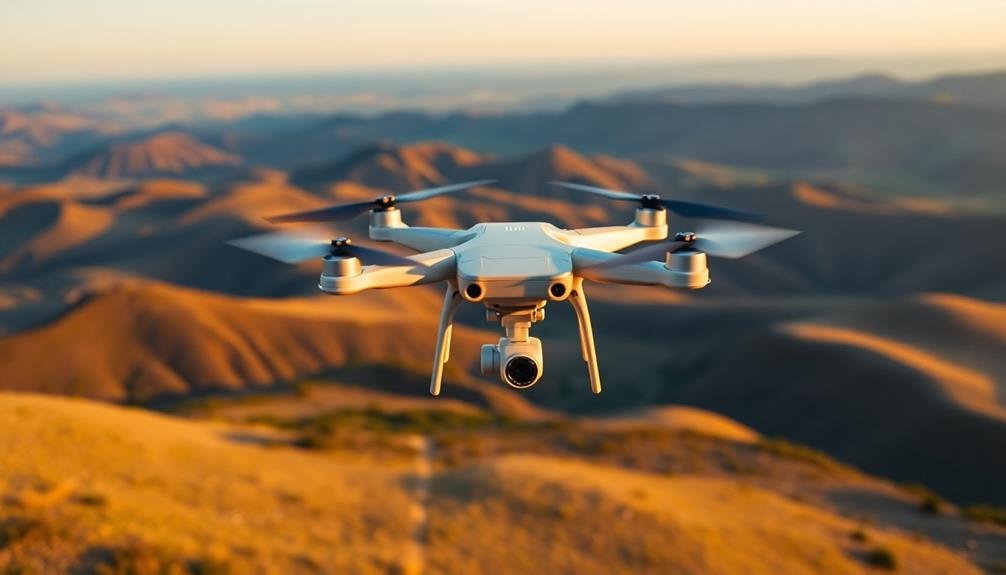
Smooth motion in drone cinematography goes beyond basic maneuvers. To elevate your figure-eight flights, you'll need to master advanced techniques.
Start by fine-tuning your drone's settings. Adjust the gimbal sensitivity and reduce the control stick's responsiveness for more fluid movements.
Practice flying at different speeds within the same shot. Begin slowly, gradually increase your pace, then decelerate as you complete the figure-eight. This dynamic speed control adds visual interest and depth to your footage.
Experiment with altitude changes during your flight path. Ascending or descending slightly as you move through the pattern can create a more three-dimensional effect.
Incorporate gentle yaw movements to add an extra layer of complexity. As you fly the figure-eight, slowly rotate the drone to capture different angles of your subject.
Master the art of reversing direction mid-flight. This technique allows you to seamlessly shift from one figure-eight to another, creating a continuous, flowing shot.
Post-Production Tips
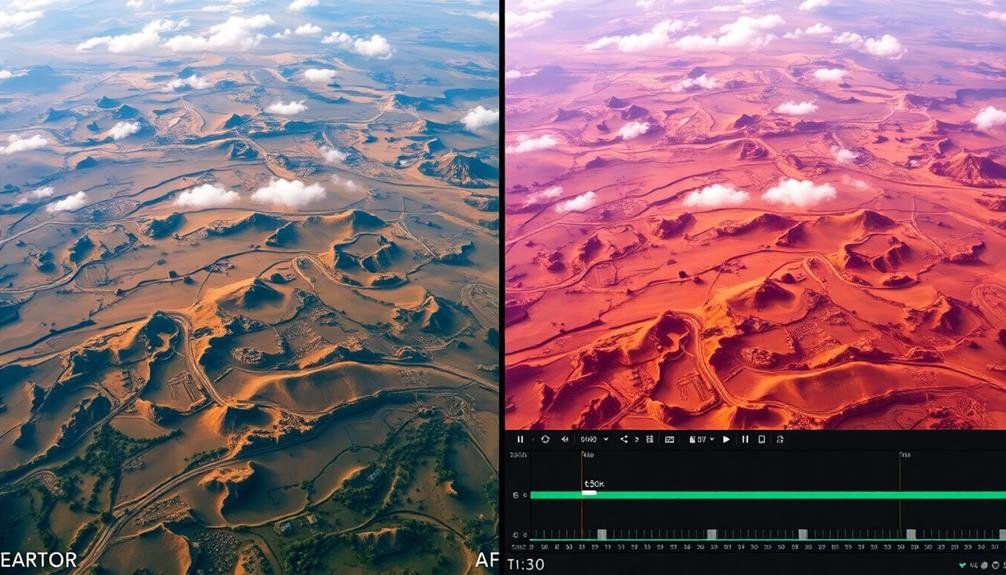
After capturing your stunning figure-eight drone footage, post-production plays an important role in enhancing its cinematic quality.
Begin by importing your footage into your preferred video editing software. Stabilize your shots if necessary, using built-in tools or third-party plugins to smooth out any remaining shakiness.
Color grading is vital for achieving a cinematic look. Apply a LUT (Look-Up Table) or create a custom color grade that complements your footage's mood and setting.
Don't forget to adjust contrast, saturation, and exposure for a polished result. Consider adding subtle effects like lens flares or light leaks to enhance the atmosphere.
However, use these sparingly to maintain a natural look. Slow motion can also add drama to your figure-eight moves – experiment with different frame rates to find the perfect balance.
Here are key post-production tips to remember:
- Use warp stabilizer for smoother footage
- Apply cinematic color grading
- Add subtle visual effects
- Experiment with slow motion
- Fine-tune audio with ambient sounds
Frequently Asked Questions
How Long Does It Take to Master Cinematic Figure-Eight Drone Moves?
You'll need dedicated practice to master cinematic figure-eight drone moves. It typically takes 2-4 weeks of regular flying to become proficient, but you can see improvement in your technique within a few days of consistent effort.
Can Figure-Eight Moves Be Combined With Other Drone Flight Patterns?
Yes, you can combine figure-eight moves with other patterns. You'll find they blend well with orbits, reveals, and dolly moves. Don't be afraid to experiment; mixing patterns creates dynamic and engaging footage for your viewers.
What Are the Best Subjects for Practicing Figure-Eight Drone Cinematography?
You'll find stationary subjects ideal for practicing figure-eight drone cinematography. Try landmarks, buildings, or natural formations. As you improve, move on to slow-moving subjects like boats or vehicles. Always prioritize safety and follow local regulations.
How Does Wind Affect the Execution of Figure-Eight Drone Moves?
Wind can considerably impact your figure-eight moves. You'll need to compensate for drift, adjust your speed, and maintain control. Strong gusts may require you to abort the maneuver. Always prioritize safety over getting the perfect shot.
Are There Specific Drone Models Better Suited for Figure-Eight Cinematography?
You'll find drones with advanced flight modes, precise controls, and stable hovering capabilities are ideal for figure-eight cinematography. Models like DJI Mavic 3, Autel EVO II Pro, and Skydio 2+ excel in these smooth, complex maneuvers.
In Summary
You've now mastered the cinematic figure-eight drone move! Remember to practice regularly and always prioritize safety. Don't be afraid to experiment with different speeds, altitudes, and focal lengths to create unique variations. As you refine your technique, you'll find endless creative possibilities for your aerial footage. Keep pushing your skills, and soon you'll be capturing breathtaking figure-eights that'll elevate your drone cinematography to new heights. Happy flying!

As educators and advocates for responsible drone use, we’re committed to sharing our knowledge and expertise with aspiring aerial photographers.




Leave a Reply